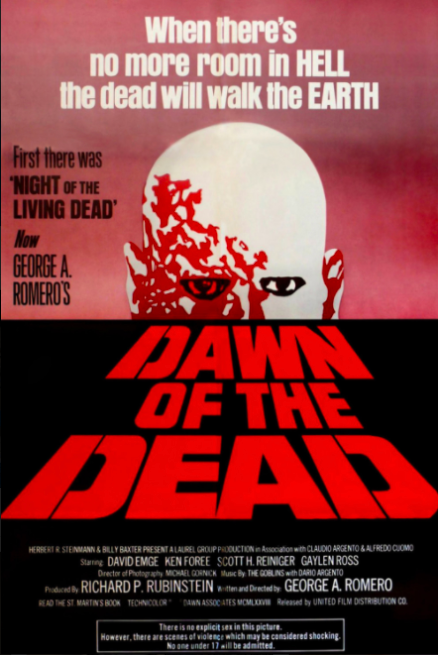Michael DiMonte ’25
Filmmaker George A. Romero’s 1978 magnum opus, Dawn of the Dead, not only took viewers by storm with its superb special effects and touching story about humanity, but also redefined the horror genre. The story follows four people who take shelter inside a Pittsburgh shopping mall after a zombie outbreak. Though its effects and humor are cheesy at times, the movie tells a story about humanity in a time of crisis and tackles controversial topics such as abortion and anarchism.
The movie starts with Flyboy and Francine, a struggling couple, meeting up with their SWAT friend Roger and another SWAT team member, Peter, who he met at a zombie containment attempt. Deciding Pittsburgh is no longer safe, the four get in a helicopter and head to what seems to be a more secure area, ultimately choosing a mall on the outskirts of the city.
Their stay at the mall starts out fine, having all the food and water they need to survive for at least a year, but the situation becomes dangerous when zombies begin breaking in and a savage motorcycle gang wants to wreak havoc.

Courtesy of @edgarwright on twitter.com
The film uses the zombie outbreak as a backdrop to look at how people behave when faced with hardships. Romero introduces characters like Roger (Scott Reiniger) and Flyboy (David Emge) to examine how human emotions can be complicated and drive people to extreme behaviors. The motorcycle gang allows Romero to explore views on anarchism as the bikers run around the mall, joyfully killing zombies and humans and stealing from corpses. Even the main characters feed into the lack of government, roaming the mall and stealing clothes, jewelry, and other merchandise. Characters like Peter (Ken Foree) and Francine (Gaylen Ross) explore divisivel topics such as race and abortion, each of which are surprising to see in a seventies film, let alone in the horror genre. Romero challenges racial barriers in his film by casting a black man as the hero. The topic of abortion is disucssed through Francine’s debate on whether or not she should give birth to her baby and raise her child in an apocalyptic environment.
Romero’s use of Tom Savini’s special effects paved the way for the brutality and gore allowed in movies today. While the green-colored zombie flesh may look humorous when comparing it to The Walking Dead, the blood squibs, flesh bites, and use of real butcher’s meat for human intestines shocked audiences at the time. These innovative effects also inspired other special effects artists, such as Pittsburgh-born Greg Nicotero, to experiment and create films like Evil Dead II (1987) and From Dusk Till Dawn (1996).
Romero enjoyed earlier success with his 1968 film, Night of the Living Dead, and with the help of Italian film producer, Dario Argento (Suspiria, 1977), the Pittsburgh director was able to create another masterpiece though casting unknown principal actors.
Leading lady Francine is a strong, independent woman throughout the movie, demonstrating Romero’s investment in diverse characters who break social norms. Gaylen Ross is superb in her portrayal of the soon-to-be mother, as the world caves in around her.
Dawn of the Dead’s greatest achievement, however, is its ability to withstand the test of time. Foreign directors like Lucio Fulci made films such as Zombi (1979) for Italian audiences as a result in the spirit of Romero’s classic. .
The movie was also a demonstration of how horror films do not need to simply be gore-fests where viewers are carelessly waiting for the characters to die. Rather, it showed that horror films could tackle sensitive topics and make statements about the world, while still entertaining audiences. Romero has made a masterpiece that can be watched during Halloween as well as during times of reflection where people want to come to a greater understanding of humanity.
